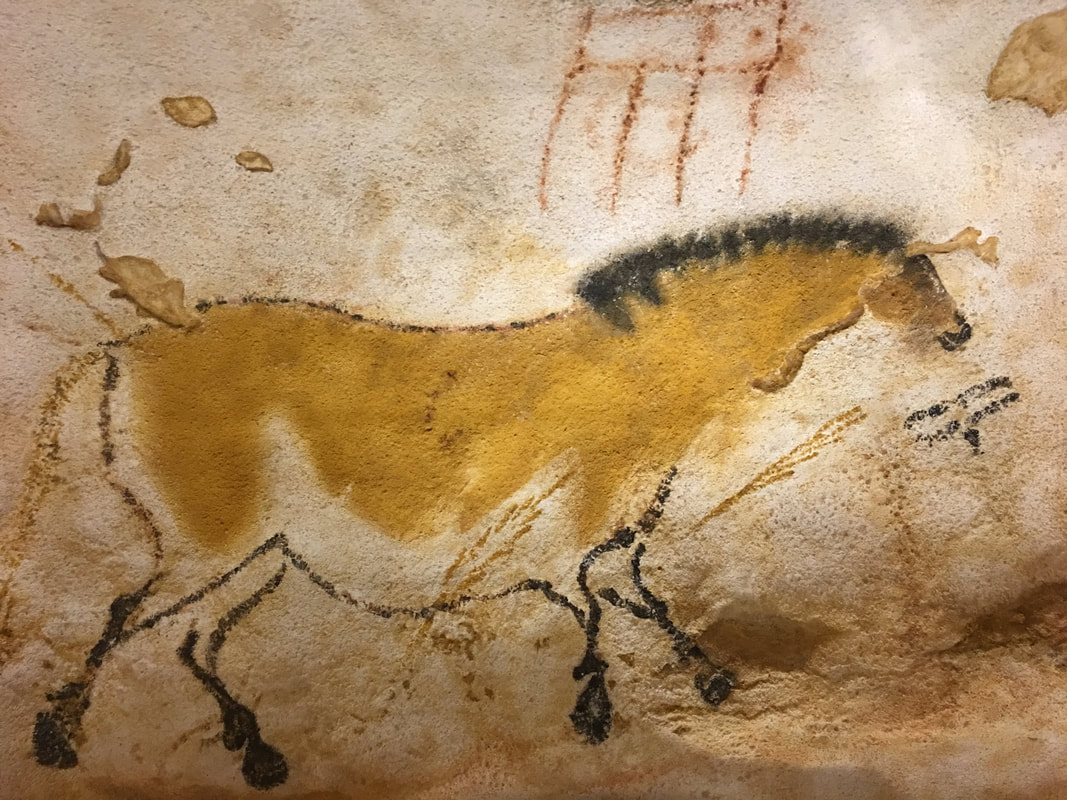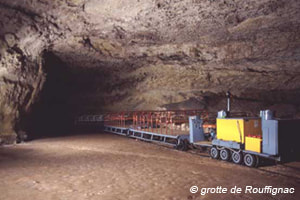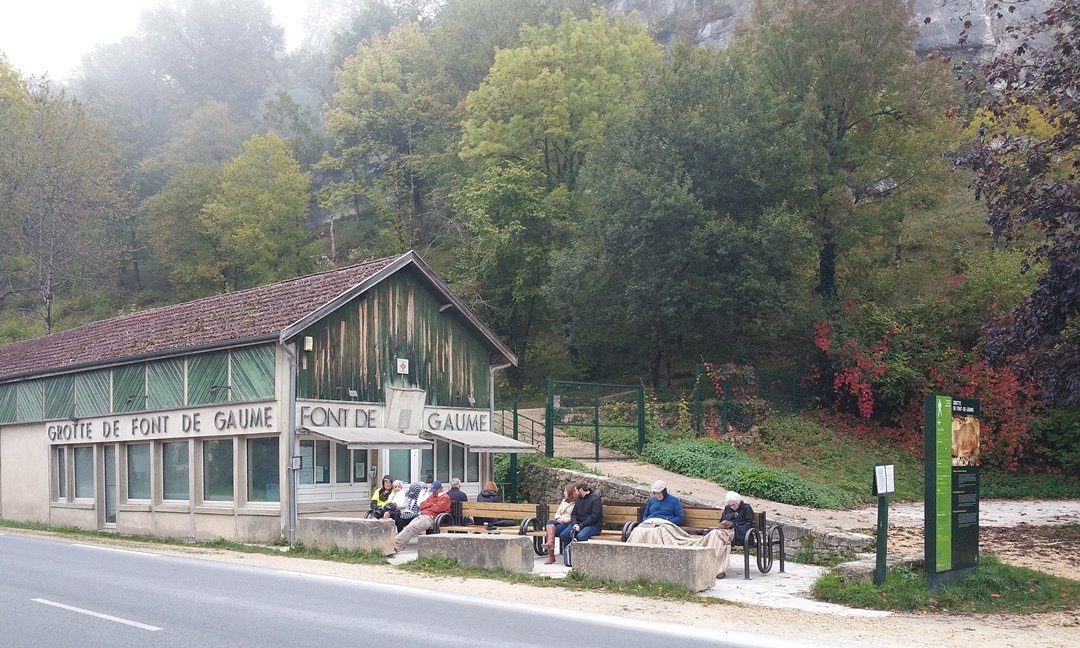For many years now, my husband and I have been visiting France's prehistoric sites, including its remarkable caves. One area in particular, la Dordogne, is a paradise of cave art dating back 30,000 to 10,000 years. In the 25 kilometers of the Vézère valley between Montignac and Les Eyzies, there are 15 caves that have been rated Unesco World Heritage sites.
We have few clues about the people who left this extraordinary cultural legacy, but the artwork was probably the work of Cro-Magnons, the first members of Homo Sapiens, who settled in Europe some 45,000 years ago and who looked like us. They are believed to have been survivors of the Ice Age that later gripped the continent.
The most famous of these caves in la Dordogne, and one you have probably heard of, is Lascaux. If you know anything about prehistoric cave art, you know that this site, with its extraordinary polychrome paintings (mostly of horses, deer and mammoths), has been rated as one of the top prehistory caves in the world, along with Southern France’s Chauvet and Spain’s Altamira, all three of which are now closed to the public. Discovered in 1940 by some French lads and a dog, Lascaux has been called the Sistine Chapel of prehistoric art. During the next two decades after its discovery, thousands of tourists flocked to see Lascaux, peaking at 120 visitors per day. This inundation of human traffic triggered changes in the delicate balance of the very small cave’s atmosphere. Increased carbon dioxide, heat, humidity and other contaminants caused the growth of algae and crystals on the artwork on its walls, and because of this, the cave was closed to the public in 1963.
Two decades later, a partial replica of the cave, known as Lascaux II, opened. When our children were young, we visited Lascaux II on several occasions. Although knowing it was a replica did impact the experience, it was still very enjoyable and educational. But wait, it just got better! To showcase its rich cultural heritage, the Dordogne General Council recently undertook an impressive building project to create The International Center for Cave Art (Centre International d’Art Parietal) located in the town of Montignac. This center, which opened in 2016, is a must-see for anyone interested in prehistory, or for anyone in the area, for that matter. In addition to a replica of nearly the entire original cave of Lascaux, down to the exact contours of the cave walls, humidity and temperature (55 degrees, so plan on taking a sweater), the “The Gallery of Imagination,” which you visit after the replica cave, includes interactive activities great for both adults and kids that allow you to examine the paintings in further detail and also to take photos. And finally, there are two interesting films presented in the center’s theaters, one of them in 3-D.
You are required to do the replica cave portion of the visit with a guide, and most of the tours are in French, although you can reserve a tour in English in advance. Furthermore, you are given a tablet with earphones, which has an English translation if you are on a tour in French. Plan at least two hours for your visit. I strongly recommend making reservations in advance as this place is very popular, especially during the summer months. You can book online between 90 days and 24 hours in advance (no online booking the day of your visit) at http://reserver.lascaux.fr/en/todo This having been said, on both occasions we visited in the past year, we did not have reservations and just hoped to be able to get in. And we did! So even if you don’t have reserved tickets, stop at the center and see if you are in luck.
Now, after my encouragements to visit a replica cave, you simply can’t travel to la Dordogne without seeing some of the original parietal art up close and personally. My number one recommendation for this is Rouffignac, about 30 kilometers from Les Eyzies near Rouffignac-Saint-Dernin-de-Reillac. This large cave (8 km long) is known as the Cave of the Hundred Mammoths. Although this cave was known for several centuries, it wasn’t until 1956 that the Abbé Henri Breuil, the Catholic priest known for his protection of prehistoric sites, authenticated the images.
Rouffignac boasts approximately 260 monochrome paintings or etchings of horses, bison, ibex but particularly wooly mammoths (160) that date back 15,000 years to the Magdalenian culture. Where the other caves are cramped and tight, Rouffignac is open and expansive. Its Great Ceiling is one of the world’s oldest and most beautiful art galleries. We have few clues as to who created it and we don’t know why these artists picked such an inaccessible spot to display their genius. We are just fortunate that it can be viewed easily today. A small open-cabin electric train runs from Rouffignac's entrance to the Great Ceiling, allowing visitors to gaze up at its wonders. In high season, tickets are sold at 9 am for the whole day, so check in advance for availability. But once again, even if you don't have reserved tickets, stop by if you are in the area to see if you can get in. We just did.
The next three prehistory sites in the area I recommend are a little more problematic and do require advance tickets. They are: Font de Gaume, Les Combarelles and L’Abri de Cap Blanc. The reason I say they are problematic is because you cannot buy advance tickets on-line. You actually have to line up in the morning at the Font de Gaume ticket office, located just outside of Les Eyzies, to get tickets for all three sites.
These sites all have restricted access, with Font de Gaume allowing only 70 visitors per day, divided into groups of 11 or smaller. In high season, it is impossible to get tickets unless you go to the ticket office by 6 or 7 am in the morning. There are numbered seats on the benches outside the ticket office and tickets are sold on a first-come first-serve basis for all three sites. The office does not open until 9:30 am and the first tour is at 10 am. If you have only one day or a half-day in the area, I would skip this cave and instead go to see Rouffignac or Lascaux IV, but if you have several days, then by all means try to do these three sites. It will take most of the day for the three sites with enough time for lunch, but the computer at the ticket office will arrange the most efficient use of your time. The sites are fairly close together.
If you can only visit one of these three sites, I would choose Font de Gaume. Be aware that it does require a walk up the hill, so you need to be at the entrance to the cave, not at the ticket office, at your appointed time. Beautiful polychrome paintings, mostly of horses, date back to 12,000 BC, and you get to see them in a small group and from a very close vantage point. Many of the tours are given in English, so ask when you are buying your tickets for an English tour.
L’Abri de Cap Blanc is not a cave, but an overhanging rock shelter where an incredible frieze of horses has been sculpted into the stone by artists who took advantage of the topography of the rock. It is truly unique in prehistoric Paleolithic art. It is not large, but really is amazing, and before you go into the actual site, there is a small museum in the visitor’s center which you can enjoy while you wait to go into the enclosed site. L'Abri de Cap Blanc is also one of the few prehistoric sites in la Dordogne where the people actually lived. There is absolutely no evidence that they ever lived in any of the caves where they left their cave art, so this site is unique in that respect.
In fact, a perfectly preserved skeleton of a Paleolithic woman (Cro-Magnon) was also found at the site. The thought that she could be one of the artists responsible for this remarkable work of art makes it even more thought-provoking. Today, the original skeleton of the Woman of Cap Blanc is on display in the Field Museum of Chicago, but a replica of the skeleton is placed in the exact location in which it was found, and a copy of a bust of what she may have looked like is displayed in the center’s museum.
Even though this is a very small site, it is so unique it's worth the visit. There is some walking to get to the visitors’ center so get to the parking lot at least 10 minutes before your assigned time. Also note that this site is closed on Saturday of all days!
Les Combarelles (above), allows only 42 visitors per day in six groups of seven. It contains almost exclusively prehistoric etchings (nearly 800) mostly of horses, with a few mammoths and a beautiful lioness (below), also dating back to about 12,000 BC. It is quite a treat to go with such a small group and see the etchings up close. Our guide was terrific and spoke excellent English. Just one word of caution: the guides often point out an etching of female genitalia, so if you have children, be prepared.
The reason this cave is the last on my list of five is because there are no paintings, and the etchings are somewhat difficult to see. However, the guides do a great job of highlighting the etchings with their flashlights and they make certain that each visitor can make see the figures before moving forward. This tour, like most of the other cave visits, lasts about one hour.
Remember to take sweaters when visiting all of the caves as they can get chilly. Also, no photography is allowed inside any of the caves.
Remember to take sweaters when visiting all of the caves as they can get chilly. Also, no photography is allowed inside any of the caves.
While in Les Eyzies, you can also visit the National Museum of Prehistory (Le Musée National de Préhistoire) located right on the main street of the village. If you have a lot of time in this area, then by all means, go. If not, your time is better spent visiting one of the caves. Parking can be tricky, and the museum isn’t well marked, so you may have to drive through the village a couple of times to figure out where to park and how to enter the museum (by walking up a small side-road). The good news is that the entrance fee is only €6.
Now, let me qualify my tempered enthusiasm about the museum by saying that it is full of interesting stuff, but in my opinion, there is something lacking in the presentation of the said “stuff.” After all, isn't it the French who say, "presentation is everything!" If you like a huge collection of every artifact discovered in the area in display case after display case, then this is the place for you! For me, it was a bit daunting and way too overwhelming to take in. Sometimes, a well-displayed “less” is "more."
I did, however, like the dioramas of how primitive men and women lived. There are laminated cards in English if you don’t understand the French captions, but to actually read everything would take several days! You can take guided tours, which would probably enhance the experience, for €9 to €11. Also, don't miss going outside the museum on the top floor to see the view of the valley and the controversial sculpture of "Primitive Man," sculpted by French artist Paul Dardé in 1931. It's controversial because it was supposed to represent Cro-Magnon man (who remember is supposed to look like us), but looks way more like a Neanderthal. Critics find it an aberration and clamor for its removal, because after all, Les Eyzies is the center for Cro-Magnon Man, but I like it. The fact that this photo captures my husband right next to the sculpture of a primitive Neanderthal means nothing. Really!
What I most enjoyed in the museum were the films of prehistoric man using and making tools, but most of these films can also be seen in the nearby Pôle International de la Préhistoire, which does not charge an entrance fee, and has parking across the street and great restrooms. You can also get information at the Pôle about all of the sites in the area, so unless you have lots of time, visit the Pôle and skip the museum.
This is not an exhaustive list of all there is to do in la Dordogne. It doesn't even come close to covering just the prehistory sites, let alone all of the other outstanding things to do and see in this area. In fact, this is one of the most interesting regions of France with its beautiful villages, troglodyte dwellings, river activities on the Dordogne River, and the incredible castles to visit, but that will be for another post.
Incidentally, if you are interested in cave art further afield from la Dordogne, I highly recommend visiting Pech Merle with it's amazing negative hands and undecipherable symbols. It is my very favorite cave in France with original cave art and is located in the Lot Department.
Incidentally, if you are interested in cave art further afield from la Dordogne, I highly recommend visiting Pech Merle with it's amazing negative hands and undecipherable symbols. It is my very favorite cave in France with original cave art and is located in the Lot Department.
Another must see is the replica of the Chauvet Cave in the Ardèche Department, which boasts a brand new complex comparable to Lascaux IV. Both of these sites are worth going out of your way for a visit.
And finally, a personal reflection. In reading tourists reviews of many prehistoric caves, I have often chuckled when the reviewer complains that the guide wasn’t very knowledgeable, often replying to visitors’ questions with an “I don’t know.” Trust me: take this reply as the sign of a good guide! I will never forget the visits we have made over the past several decades to these same sites and hearing an ad nauseam spewing of speculation disguised as fact, especially all of the sexual innuendo we once heard in Les Combarelles with our young children in tow. In recent years, sanity has returned to the profession of Prehistoric Cave Guiding in la Dordogne. The true answers, especially as to “WHY” they did it, “WHY” they chose such inaccessible spots to display their talents, or “WHY” they chose to depict certain animals, are “we don’t know,” and any guide who claims otherwise is a charlatan! Modern man can give a detailed explanation of how the cave was discovered, give comparative examples of the art from different caves, determine the years the paintings were made through carbon dating of various artifacts found in the areas, and can often determine what methods and materials were used. He can even give theories, but they should be presented as such. The truth is, we simply do not have an answer as to the whys, so don’t be bothered if you hear a guide say “I don’t know.” It’s the right answer! Happy spelunking!






















 RSS Feed
RSS Feed